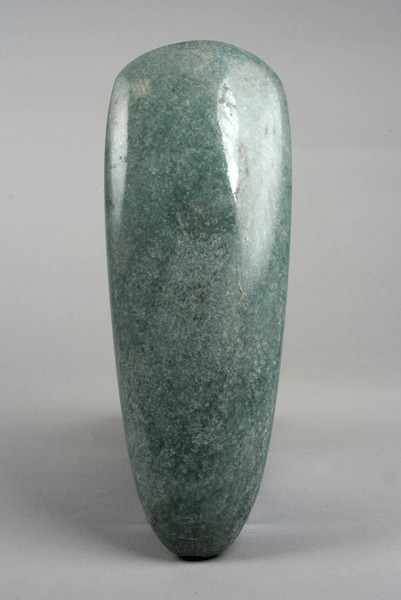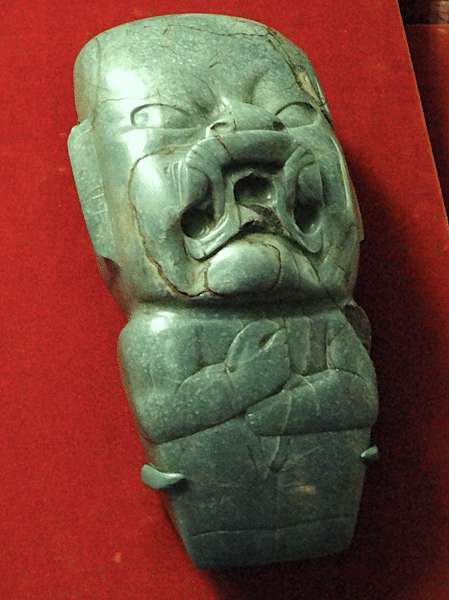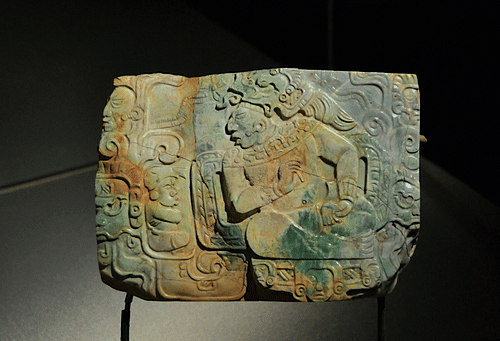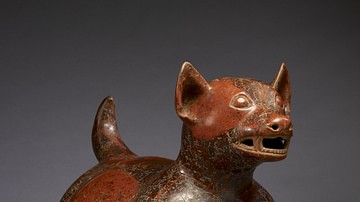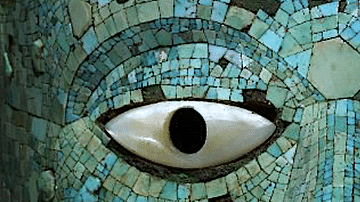Jade was a highly-esteemed material in many Mesoamerican cultures, making it a valued regional trade good and first choice for objects of religious and artistic value such as masks, ceremonial axeheads, figurines, and jewellery. Jade, because of its green colour, was associated with life, water, vegetation (especially maize shoots), and regeneration; some cultures also credited the stone with healing powers.
Properties & Associations
The term 'jade' actually covers two materials: jadeite and nephrite, but only the former is naturally found in Mesoamerica. This mineral aggregate stone is often found in deposits of serpentine, a type of greenstone. In central Mexico the name for jade was chalchihuitl.
On the plus side, jade was easily found in the form of water-worn pebbles along or in the beds of certain rivers, but on the negative side, jadeite is a very hard material and so it could only be carved by ancient craftworkers with difficulty. Carvers used tools made of the same hard material with string saws or tubular drills and with powdered jade (or quartz) as an abrasive. The relative rarity, hardness, striking green colour, and polished sheen of the stone were all reasons why it was highly valued throughout the history of Mesoamerica in cultures such as the Olmec, Teotihuacan, Zapotec, Maya, and Aztecs. Even today, the region continues to be a significant supplier of jade.
Jade was also esteemed because of its association with other important elements of Mesoamerican culture. The colour of jadeite, which ranges from blue-green to deep green, meant that Mesoamericans linked it with the sky, vegetation (particularly the young shoots of maize), and water. Jade represented intangible ideas, too, notably the concept of life, abundance, and regeneration. Because of these associations, jade was used in artworks that represented such ideas, either the entire work being made from the precious material or having jade inlaid into a less valuable material. Using a piece of jade to represent the heart of a sculpted figure was not uncommon or to indicate the representation was of a divinity. Due to its association with life and renewal, small pieces of jade were sometimes placed in the mouth of the deceased before burial. Finally, it seems that pieces of worked jade were handed down from one generation to another and so were frequently treated as prized heirlooms.
Olmec Jade
The Olmec civilization flourished in Mesoamerica from c. 1200 BCE to c. 400 BCE. Their heartlands were the region of the Gulf of Mexico which are today the states of Veracruz and Tabasco, but they established trade networks stretching as far south as present-day Nicaragua. The Olmec likely acquired their duller-coloured jade from various locations, perhaps as far away as north-east Costa Rica, but the Olmec showed a distinct preference for blue-green shades of the stone, and these were only available from Guatemala. Excavations in the Sierra de las Minas above the Rio Motagua have shown several Olmec-period workshops of jade close to the source of this most valued type of jadeite.
Olmec craftworkers principally used jade to create figurines of their gods, funeral portrait masks, and objects used by priests in rituals. Small, flattish figurines may have been worn as amulets; the presence of a drilled hole suggests a cord was put through them. Sometimes red cinnabar was used to cover a jade piece or highlight the incisions made in the stone.
Another common type of jade figurine from the Gulf Coast region is figures of humans, often dwarf-like, sitting cross-legged or standing with legs apart. A tomb in La Venta revealed a curious arrangement of 17 individual jade and serpentine human figures, all standing together on a sand base in what seems to be an assembly of some sort. Miniature celts (ceremonial axe heads) were positioned on one side of the group, but the meaning of this assemblage of jade is not known.
Perhaps the most significant Olmec jade carving, and certainly the largest of its type at 11 inches (28 cm) in height, is the Kunz Axe (named after its former owner), a ceremonial axe head now in the American Museum of Natural History in New York. The jade has been worked to represent a were-jaguar creature, using only jade tools, and then polished, perhaps using a jade abrasive. Animals were a popular subject in Olmec art, especially those most powerful ones such as jaguars and eagles, but such hybrid figures could represent shamans who sought, during trances, to take on the powers of certain animals. Jade ceremonial and highly stylised axe heads were deposited in tombs in large quantities as these likely represented maize shoots and so, by association, renewal and regeneration. The Kunz Axe is a much more elaborate type of celt and was perhaps not buried since sections of jade have been removed periodically from the rear side, a testimony to the preciousness of this material.
Maya Jade
The Maya of Mexico and Central America had a source of jade in Guatemala, which came in various shades from pale to dark green. Maya craftworkers carved jade using stone and bone tools. Elite members of Maya society wore jade jewellery such as earspools, lip plugs, necklaces, bracelets, anklets, pendants, and belts.
As with earlier Mesoamerican cultures, the Maya gave jade a religious significance, and it was associated with life and regeneration. The Maya maize god was associated with jade and often represented in art holding a sheaf of grain, which, in sculpture, could be rendered using jade. Several monsters in Maya mythology have jade body parts, such as the giant bird Wuqub Kaquix, which had formidable green jade teeth but was slain by the Hero Twins Hunahpu and Xbalanque.
The Maya produced fine jade plaques which are incised to replicate the style of carvings in stone on their buildings. One fine example from Nebaj, Guatemala, created around 600 and now in the National Museum of Guatemala, shows a seated figure, perhaps a maize god or Maya lord, peering down at a much smaller figure (a court dwarf?) reminiscent of Olmec figurines made from jade. Such jade plaques were cut as slabs from large boulders of jade using wooden or cane saws embedded with crushed abrasive material such as basalt, sandstone, or jade.
Excavations at Cancuén have revealed a workshop dedicated to jade, confirming northern Guatemala was an important centre for the stone. A massive 200 lb (90 kg) jade boulder was excavated from the foundations of a temple at Kaminaljuyu, which shows how Guatemalan jade was cut for work on smaller pieces. The boulder has a deep V-shaped cut in it where slabs of jade have been removed.
We know from deposits in cenotes (sacred wells or sinkholes) at Maya sites like Chichen Itza that jade objects were frequently offered as a material sacrifice to the gods and, as illustrated at sites like Seibal and Cival in Guatemala, that caches of jade objects were buried in the foundations of important new buildings. Maya Tikal provides some unique objects in Mesoamerican art, mosaic jade-covered ceramic or wooden jars, sometimes perhaps showing actual portraits of the deceased they accompanied in their tombs as figures on the lid. A particular jade celt, a sort of portable stela, is probably from the tomb of Moon Zero Bird, ruler of Tikal. Called the Leiden Plaque, it is carved with a full-length portrait of that ruler stamping on a captive and is marked with his accession date, equivalent to 17 September 320, making it one of the oldest dated Maya artefacts.
Like the Olmec, masks were made of jade, and none is more striking than the mosaic jade mask of the Maya ruler K'inich Janaab' Pakal (aka Pacal the Great, l. 603-683). This mask had been placed on the dead ruler's face along with masses of jade-beaded jewellery around his neck and wrists. The ruler's sarcophagus was even guarded by two attendants carved in jade. Pakal's remains were interred deep within the Temple of the Inscriptions pyramid at Palenque, Mexico. The mask and other artefacts from the tomb are now on display in the National Museum of Anthropology in Mexico City.

Finally, at Copan in Honduras, the occupant of one tomb – identified by some historians as the remains of the 5th century Maya ruler-founder K'inich Yax K'uk' Mo' – had his incisors inlaid with jade. It seems the Maya did not lack imagination in terms of the symbolic and decorative uses they could put jade to.
Aztec Jade
Jade continued to be appreciated by Mesoamerica's last great civilization, the Aztecs (aka Mexica). In 14-16th-century Mexico, the Aztecs associated jade with a particular goddess whose name derives from that of the stone. Chalchiuhtlicue or 'She of the Jade Skirt,' was a goddess of the sea, rivers, lakes, and springs. She was associated with the day Serpent and trecena 1 Reed. She is 3rd of the 13 Lords of the Day and 6th of the nine Lords of the Night. The Gulf of Mexico, perhaps because of its green colour, was known as Chalchiuhcueyecatl or 'Waters of Chalchiuhtlicue'.
The Aztecs were great collectors of art and religious objects made by their predecessor civilizations, and jade was particularly prized. It may be that the Aztecs actively hunted for jade artefacts in the ruins of those Mesoamerican civilizations which had risen and fallen centuries before. Once acquired, many such recovered pieces were then reburied again in the foundations of important Aztec buildings like temple pyramids. There is some evidence that members of the Aztec elite used these 'antiques' to emphasise their connection to past elites and legitimise their rule in the present.
The Aztecs carved their own works in jade and perfected a technique to give the stone a final, brilliant polish using pieces of cane. The Aztecs believed that jade had healing properties and was particularly effective against problems of the liver, kidneys, and spleen. This led to a series of confusions and mistranslations in the name jade when contact with Europeans was made in the second decade of the 16th century, as here explained by the historian M. Miller:
They [the conquistadors] called it loin-stone, or piedra de ijada in Spanish. Sir Walter Raleigh commented on these miraculous curing stones of the loins in the 1580s, but the word jade, a corruption of ijada, only came into the English language later. When it was catalogued and given a Latin name by Europeans, they called it lapis nephriticus, from the Latin word for kidney, nephrus, yielding the word nephrite, which they then applied to Asian jade. The confusion was compounded in modern times, when two distinct compounds were identified, nephrite and jadeite. (102)
A curious consequence of the Mesoamerican fascination with green jade was that when the conquistadors arrived they were able to trade cheap green glass beads for gold and other valuable goods since the Aztecs and Maya thought these beads had similar properties to their much-loved jade.

